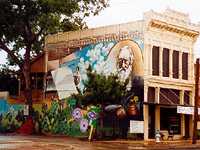|
Most
of us don’t pay attention to the full or scientific names of plants
but even those who don’t might think the name Lindheimer sounds familiar,
especially in Texas. About 50 species
and sub-species of plants are named for Ferdinand Lindheimer, a man
born to the good life in Germany who made his name – and the name
of all those plants – on the Texas frontier.
Politics, or at least the formation of political views, was as much
a part of Lindheimer’s life as his lifelong love of botany. Born at
Frankfurt-on-the-Main in 1801, he was university-educated and taught
at the Bunsen Institute, which German authorities suspected of training
revolutionaries instead of scientists or, worse, both. Six teachers
at the school were charged with sedition, which is generally translated
to mean they stirred up trouble.
Lindheimer, an outspoken opponent of the autocratic German government,
decided his best move would be to the United States, where freedom
was cherished. He settled first in Illinois but set out for Texas
in 1834 aboard a flatboard boat bound for New Orleans, where he planned
to stock up on provisions for his trip to Texas.
Instead, he ended up in Mexico,
worked as a distiller for a coffee plantation and overseer of a pineapple
and banana plantation. In his spare time, he collected plants and
insects. His hatred of oppression reportedly resulted in him declining
a commission in Santa Anna’s army. News of the Texas revolution distracted
and excited him enough that he joined up with the Texas army in 1835
but arrived at San
Jacinto one day after the decisive battle. He served under the
command of John
Coffee Hays until 1837.
Lindheimer continued studying the plants and insects of this new land
while eking out a living farming near Houston.
He went to St. Louis in 1839 where he worked out an arrangement with
Professor Asa Gray of Harvard and George Engelmann of the Missouri
Botanic Garden to investigate the flora of Texas,
which he did for the next nine years.
Starting in Galveston
in 1843, Lindheimer worked his way west with stops in Chocolate Bayou,
Cat
Springs, Matagorda Bay, Indianola,
Comanche Springs, and the valleys of the Colorado, Guadalupe and Brazos
rivers. Along the way he found a new sub-species of loco weed, a new
milkweed, mimosa, prickly pear and rock daisy; in all, he collected
between 80,000 and 100,000 specimens.
In 1844, Lindheimer met Prince Carl Solms-Braunfels, a fellow German,
who was making plans to establish a German settlement in Texas
that would become New
Braunfels. Lindheimer served as a guide for the new
German settlers, members of the Adelsverein, and he would stay
on a cabin on the banks of the Comal
River for the rest of his life. |
 |
New
Braunfels mural just off the square shows landscapes, flora, fauna
and indigenous peoples of the region. There's also an 20-foot image
of Lindheimer
TE Photo |
Ferdinand Roemer,
a German scientist, described Lindheimer’s cabin as being just outside
of town, half hidden by oaks on the river banks. “It furnished an
idyllic picture with its enclosed garden and general arrangement and
position,” he wrote. “When I neared this simple rustic home, I spied
a man in front of the entrance busily engaged in splitting wood. Apparently
he was used to this kind of work.” That was Lindheimer.
Lindheimer married and raised a family and served as publisher of
the New Braunfels Herald Zeitung, a German-language paper, for 20
years. He used the paper to extol the virtues of freedom, truth and
justice, though it’s said that some of his writing was hard for the
average reader to decipher. One person who seemed to understand Lindheimer
well enough was Comanche chief Santanta, a frequent visitor to the
Lindheimer home.
The start of the Civil War put Lindheimer in an odd position. Though
his personal writings made it clear that he was opposed to slavery,
he urged his readers to be loyal to their new country, the Confederacy.
This was probably a matter of self preservation. Several of his fellow
freedom-loving Germans in the area were killed as a result of their
outspoken support of the Union. |
|
|
The
Lindheimer Home
(c. 1852)
491 Comal St.
TE Photo |
Lindheimer died
in New
Braunfels in 1879. His house, now a museum, has been restored
to look much as it would have in his day with a lot of period furniture,
including work by master cabinetmaker Johann Jahn.
Of the many German immigrants who helped settle the state, Lindheimer’s
talents were possibly the most diverse. His main claim to fame, though,
will always be his pioneering work in Texas botany. His collections
are housed at more than 20 institutions, including the Missouri Botanical
Gardens, the British Museum in Paris, and universities in Germany
and Spain.
More than likely, subjects of his work probably also lives on as part
of your lawn, pasture or garden. Some plant discovered by Lindheimer
or named for him is probably taking root right now.
© Clay Coppedge
"Letters from Central Texas"
April 12, 2011 Column |
|
|
